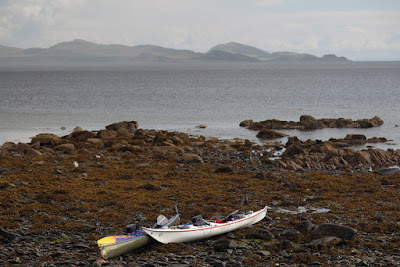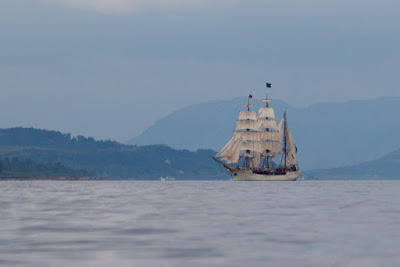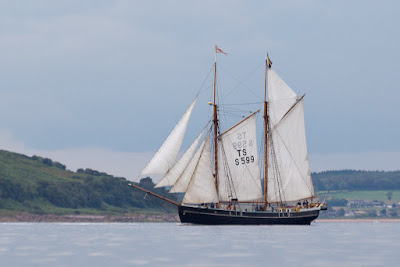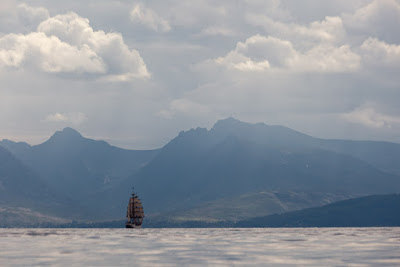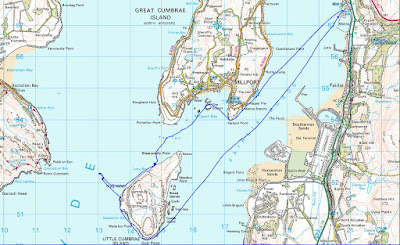After an excellent luncheon, Jim and I started our return journey from Scalpsie Bay to Portencross.
You certainly will not miss Jim's new Taran on the water.
My all white kayak is really rather plain in the Taran's company!
To the west, storm clouds gathered...
...above the Arran mountains and there was distant rumble of thunder in the air.
Then the full storm unleashed itself on Glen Sannox.
Imagine you are at the edge of the sea on a day when it is difficult to say where the land ends and the sea begins and where the sea ends and the sky begins. Sea kayaking lets you explore these and your own boundaries and broadens your horizons. Sea kayaking is the new mountaineering.
Showing posts with label Arran. Show all posts
Showing posts with label Arran. Show all posts
Monday, September 05, 2011
Sunday, September 04, 2011
Not enough puff for the West Kyle!
In the wind shadow of Scalpsie Bay on Bute we caught up with Tony and Gavin's news while enjoying the view to Arran's rocky ridges over the Sound of Bute.
as the spring tide rapidly ebbed from the bay...
...it was time for Tony and Gavin to depart. They had a long slog against the tide and wind up the west Kyle to the Burnt Islands area where they planned to camp.
Jim and I had originally planned to accompany them as far as Inchmarnock at the entrance to the West Kyle before returning to Portencross. Unfortunately some of the pain killers I have been taking for my knee have aggravated my asthma so I decided we had come far enough. As Jim and I finished our lunch, HMS Dragon slowly cruised down the Clyde on her sea trials. She didn't appear to be in a hurry to go anywhere either.
as the spring tide rapidly ebbed from the bay...
...it was time for Tony and Gavin to depart. They had a long slog against the tide and wind up the west Kyle to the Burnt Islands area where they planned to camp.
Tony's new Cetus is certainly sparkly!
Saturday, September 03, 2011
A castle and two forts on the way to Scalpsie Bay, Bute.
Jim and I met at the recently restored Portencross Castle on the Ayrshire coast of the Firth of Clyde. Normally we launch down slippy rocks from the car park but recently my knee has been really bothering me and the rocks were not an option. We therefore used our trolleys to carry the kayaks a few hundred meters to the little beach by the castle.
Tony and Gavin were on a camping trip round Bute and had arrived at Glencallum Bay at 10pm the previous night. We hoped to meet them at Garroch Head.
This was Jim's first outing (in home waters) of his new Rockpool Taran. A gusty NW wind slowed our crossing and...
...by the time we rounded Garroch Head and landed at Dunagoil Bay, we had missed Tony and Gavin.
After a quick luncheon spent admiring Jim's paint job...
...we departed from Dunagoil as heavy clouds rolled in, obscuring the Arran mountains.
...Tony and Gavin.
Tony and Gavin were on a camping trip round Bute and had arrived at Glencallum Bay at 10pm the previous night. We hoped to meet them at Garroch Head.
This was Jim's first outing (in home waters) of his new Rockpool Taran. A gusty NW wind slowed our crossing and...
...by the time we rounded Garroch Head and landed at Dunagoil Bay, we had missed Tony and Gavin.
After a quick luncheon spent admiring Jim's paint job...
...we departed from Dunagoil as heavy clouds rolled in, obscuring the Arran mountains.
We soon passed Dunstrone, which like Dunagoil, has an Iron Age hill fort on its summit.
We left Dunagoil and Dunstrone on the horizon behind us and landed at Scalpsie Bay, where we eventually caught up with...
Saturday, July 16, 2011
Fish and ships, part two.
No sooner had we finished our freshly caught fish suppers than the explanation of the VHF radio chatter was apparent. a procession of tall ships was making its way down the Clyde. The leader was Mir, St Petersburg, Russia. She is a 108.8m long square rigged ship and was built in Poland in 1987.
We paddled out to the edge of the shipping channel.
PS Waverley, Glasgow, Scotland appeared, followed by...
...a procession of the most beautiful ships. This is Sorlsandet, Kristiansand, Norway. She is a 64.2m long square rigged ship and was built in 1927.
The Waverley was built in Glasgow in 1947 in the Inglis Yard, which is now the site of Glasgow's new transport museum.
The Waverley now turned round to head back up the Clyde.
Europa, The Hague, Netherlands. She is a 54.6m long 3 masted barque built in 1911.
Constantia, Stockholm, Sweden. She is a 31.45m long 2 masted gaff schooner built in 1908.
Europa and Pelican.
Pelican and Europa.
Pelican of London, Weymouth, London, UK. She is a 44.42m long 3 masted barquentine built in 1948. However her rig is a very modern, designed to go to windward much better than a fully square rigged ship.
Europa.
Europa was one of the few to turn right towards the Kilbrannan Sound on the west coast of Arran.
the ex RNLI lifeboat Grace Patterson Ritchie (70-002) is now privately owned and based at Largs. She was built by Yarrows on the Clyde in 1966. She was the first of three Clyde class lifeboats and the first steel hulled RNLI lifeboat.
MV Llanreath is a converted Milfordhaven pilot vessel/tug. She is privately owned and based in Girvan.
Gloria, Cartagena, Colombia. She is a 65.61m long 3 masted barque built in Bilbao in 1968.
Gloria.
Gloria.
Irene, Bridgewater, UK. She is a 35.45m long gaff ketch built in Bridgewater in 1907.
Irene.
Pogoria, Gdynia, Poland. She is ia 49.52m 3 masted barquentine built in 1980.
Pogoria.
Pogoria.
Eventually we decided to land on the Little Cumbrae again but had to paddle past the resident pod of porpoises.
It was time for a well deserved third luncheon...
...then home for tea. All this within an hour's drive of home!
The full list of tall ships in the 2011 tall ships race can be found here.
We paddled out to the edge of the shipping channel.
PS Waverley, Glasgow, Scotland appeared, followed by...
...a procession of the most beautiful ships. This is Sorlsandet, Kristiansand, Norway. She is a 64.2m long square rigged ship and was built in 1927.
The Waverley was built in Glasgow in 1947 in the Inglis Yard, which is now the site of Glasgow's new transport museum.
The Waverley now turned round to head back up the Clyde.
Europa, The Hague, Netherlands. She is a 54.6m long 3 masted barque built in 1911.
Constantia, Stockholm, Sweden. She is a 31.45m long 2 masted gaff schooner built in 1908.
Europa and Pelican.
Pelican and Europa.
Pelican of London, Weymouth, London, UK. She is a 44.42m long 3 masted barquentine built in 1948. However her rig is a very modern, designed to go to windward much better than a fully square rigged ship.
Europa.
Europa was one of the few to turn right towards the Kilbrannan Sound on the west coast of Arran.
the ex RNLI lifeboat Grace Patterson Ritchie (70-002) is now privately owned and based at Largs. She was built by Yarrows on the Clyde in 1966. She was the first of three Clyde class lifeboats and the first steel hulled RNLI lifeboat.
MV Llanreath is a converted Milfordhaven pilot vessel/tug. She is privately owned and based in Girvan.
Gloria, Cartagena, Colombia. She is a 65.61m long 3 masted barque built in Bilbao in 1968.
Gloria.
Gloria.
Irene, Bridgewater, UK. She is a 35.45m long gaff ketch built in Bridgewater in 1907.
Irene.
Pogoria, Gdynia, Poland. She is ia 49.52m 3 masted barquentine built in 1980.
Pogoria.
Pogoria.
Eventually we decided to land on the Little Cumbrae again but had to paddle past the resident pod of porpoises.
It was time for a well deserved third luncheon...
...then home for tea. All this within an hour's drive of home!
The full list of tall ships in the 2011 tall ships race can be found here.
Wednesday, May 11, 2011
An effective navigational strategy for the Arran crossing.
The sails had driven us so quickly that we very nearly made the earlier ferry back to Ardrossan. The ferry attracted our attention because (unusually) it gave several blasts on its horn. It was being trailed by a noisy tribe of jet skis riding its wake. Every so often one of the bolder ones would skillfully cut across the ferry's bow, under the admiring gazes of the many passengers crowding the rail. The captain would then let off a blast. By following the ferry, the jet skis manage to cross to Arran then return to Ayrshire from whence they came. It's quite an effective navigational strategy.
It wasn't long until we were back on the little beach beside the ferry terminal at Brodick.
We sorted out our gear leisurely until the MV Caledonian Isles (minus jet skis)...
...made her return approach.
Once aboard, we made our way up to the aft deck to take a last view south towards Holy Island and...
...north to the mountains above the villages of Corrie and Sannox.
Soon we were back in Ardrossan and we waited with the cyclists to disembark behind the cars. There is no charge to take a kayak onto a Calmac ferry but I strongly suggest you invest in a trolley. The ferries operate on a very fast turn round and you will not be popular if you hold up loading as you attempt to carry several kayaks the length of the car deck, the link span and the approach road!
By the time we had unloaded the contents of our hatches into our trusty Ikea bags, a full load of cars (including the extra mezzanine deck) had loaded and MV Caledonian Isles was on her way to Arran again. Once the traffic had cleared we walked through to the car park and paid £6 for having left the cars for three nights in a secure car park with a 24 hour attendant, quite a bargain!
Our trip round Arran was over. David and I reflected on how lucky we had been to share such a mellow trip amidst such fantastic scenery.
It wasn't long until we were back on the little beach beside the ferry terminal at Brodick.
We sorted out our gear leisurely until the MV Caledonian Isles (minus jet skis)...
...made her return approach.
Once aboard, we made our way up to the aft deck to take a last view south towards Holy Island and...
...north to the mountains above the villages of Corrie and Sannox.
Soon we were back in Ardrossan and we waited with the cyclists to disembark behind the cars. There is no charge to take a kayak onto a Calmac ferry but I strongly suggest you invest in a trolley. The ferries operate on a very fast turn round and you will not be popular if you hold up loading as you attempt to carry several kayaks the length of the car deck, the link span and the approach road!
By the time we had unloaded the contents of our hatches into our trusty Ikea bags, a full load of cars (including the extra mezzanine deck) had loaded and MV Caledonian Isles was on her way to Arran again. Once the traffic had cleared we walked through to the car park and paid £6 for having left the cars for three nights in a secure car park with a 24 hour attendant, quite a bargain!
Our trip round Arran was over. David and I reflected on how lucky we had been to share such a mellow trip amidst such fantastic scenery.







